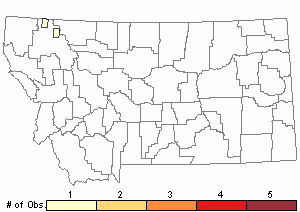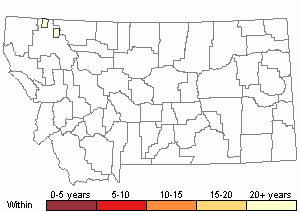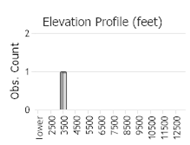View in other NatureServe Network Field Guides
NatureServe
Montana
Utah
Wyoming
Idaho
Wisconsin
British Columbia
South Carolina
Yukon
California
New York
A Tortella Moss - Tortella inclinata
General Description
Plants: Acrocarpous (Vitt 1988). Growing in crowded clumps of upright shoots (Crum & Anderson et al. 1981), green with yellow tones to brownish. Stems 5-15 mm tall; rhizoids few at the base and mostly lacking above, reddish; hyalodermis present; central strand not present (FNA 2007).
Leaves: Slightly curved and crisped when dry, spreading ca 45 degrees or more when wet, generally lance-shaped with sides nearly parallel for much of their length from the base, deeply cupped, not wavy, 1-2 mm in length; margins flat to upright, widely curved inward above; apex hood-like with both sides curved inward, occasionally acuminate (FNA 2007), acute or somewhat obtuse (Lawton 1971); costa extending shortly beyond apex (by up to 3 cells), glossy (FNA 2007).
Leaf Cells: Costa cells smooth and 8:1 on ventral surface, the dorsal surface sometimes rough, and more so above, dorsal and ventral stereid bands present with 1 row of median guide cells; lower laminal cells hyaline, light yellow, long, thin-walled and easily broken, the transition to the green, upper laminal cells sudden, the line of demarcation somewhat U-shaped; upper laminal cells square and covered with sharp, C-shaped papillae on both sides; marginal cells scalloped with sharp papillae, not bordered (FNA 2007).
Tortella inclinata var. inclinata: Present in Montana.
Stems yellow-green to yellow, short (to 10 mm), simple or with few branches, the rhizoids typically noticeable; cross-walls of cells in X-section same width as outer ventral and dorsal walls; papillae not raised; leaf point of 1-3 cells (FNA 2007).
Tortella inclinata var. densa:
Stems frequently green with strong orange tones, just orange, or greyish-green above and nearly black below, tall (to 20 mm), with numerous branches, the rhizoids obscure in the leaf axils; leaves dense and more often acuminate than hood-like; cross-walls of cells thinner in X-section than those of the outer ventral and dorsal walls; papillae seeming to be raised on a pedestal; leaf point of 5-7 cells (FNA 2007).
Phenology
Variety inclinata: Capsules ripen in last part of spring (FNA 2007).
Range Comments
North American Range
Variety inclinata: AK to NT, s to BC and MT, ON, QC, MN, IA, MI and OH (FNA 2007). Known in Montana from Flathead County (Elliott 2016).
Variety densa: AK, NT, BC, MI, WI, and VT (FNA 2007).
Observations in Montana Natural Heritage Program Database
Number of Observations: 2
(Click on the following maps and charts to see full sized version)
Map Help and Descriptions
Relative Density

Recency



 (Observations spanning multiple months or years are excluded from time charts)
(Observations spanning multiple months or years are excluded from time charts)
Habitat
Variety inclinata: Calcareous silt and larger sediments, often loosely gathered materials, such as small rocks along rivers, gravel near bogs, exposed sandy areas in coniferous or deciduous tree groves, frequently near fresh water (FNA 2007).
Variety densa: Loose rocks and sandy soils on hills, fissures in bluffs, damp sandstone shelves, lake and stream alluvium (FNA 2007).
Ecology
Variety inclinata often serves as a pioneer species, colonizing less stable habitats, whereas variety densa appears connected with more established areas (FNA 2007).
Reproductive Characteristics
Dioicous. Perigonia unseen. Perichaetial leaves long, 2-5.5 mm, upright from a wide, occasionally swollen base which envelops the stem, remaining erect when dry (unlike vegetative leaves), becoming distinctively differentiated when archegonia are fertilized (in variety inclinata). Seta yellow, becoming red below with age, 1.5-2.7 cm tall. Capsule 1.5-2 mm in length (FNA 2007); urn typically longer than the operculum (Lawton 1971); peristome teeth single, 32 in number, reddish-orange, filiform, twisted more than 1 revolution, to 0.7 mm (FNA 2007).
No specialized vegetative reproduction (FNA 2007).
Stewardship Responsibility
References
- Literature Cited AboveLegend:
 View Online Publication
View Online Publication Crum, H.A. and L.E. Anderson. 1981. Mosses of Eastern North America. 2 volumes. Columbia University Press, New York. 1328 pp.
Crum, H.A. and L.E. Anderson. 1981. Mosses of Eastern North America. 2 volumes. Columbia University Press, New York. 1328 pp. Elliott, J.C. and A.K. Pipp. 2018. A Checklist of Montana Mosses (1880-2018). Updated 3 January, 2020. Montana Natural Heritage Program, Helena, Montana. 73 pp.
Elliott, J.C. and A.K. Pipp. 2018. A Checklist of Montana Mosses (1880-2018). Updated 3 January, 2020. Montana Natural Heritage Program, Helena, Montana. 73 pp. Flora of North America Editorial Committee, eds. 2007. Flora of North America North of Mexico. Volume 27. Bryophytes: Mosses, Part 1. Oxford University Press, Inc., NY. xxi + 713 pp.
Flora of North America Editorial Committee, eds. 2007. Flora of North America North of Mexico. Volume 27. Bryophytes: Mosses, Part 1. Oxford University Press, Inc., NY. xxi + 713 pp. Lawton, E. 1971. Moss Flora of the Pacific Northwest. Hattori Botanical Laboratory. Japan: Yamabuki-cho, Shinjuku-ku, Tokyo. 362 pages plus appendices.
Lawton, E. 1971. Moss Flora of the Pacific Northwest. Hattori Botanical Laboratory. Japan: Yamabuki-cho, Shinjuku-ku, Tokyo. 362 pages plus appendices. Vitt, D. J. Marsh, and R. Bovey. 1988. Mosses, Lichens & Ferns of Northwest North America. Seattle, WA: University of Washington Press. 296 p.
Vitt, D. J. Marsh, and R. Bovey. 1988. Mosses, Lichens & Ferns of Northwest North America. Seattle, WA: University of Washington Press. 296 p.
- Additional ReferencesLegend:
 View Online Publication
View Online Publication
Do you know of a citation we're missing? Elliot, J. C. 1993. Second checklist of Montana mosses. Unpublished report. U.S. Forest Service, Region 1. Missoula, MT. 45 pp.
Elliot, J. C. 1993. Second checklist of Montana mosses. Unpublished report. U.S. Forest Service, Region 1. Missoula, MT. 45 pp. Lawton, E. 1971. Keys for the Identification of the Mosses on the Pacific Northwest. Reprinted from 'Moss Flora of the Pacific Northwest'. Published as Supplement No. 2 of the Journal of the Hattori Botanical Laboratory. Nichinan, Miyazaki, Japan. 66 pp.
Lawton, E. 1971. Keys for the Identification of the Mosses on the Pacific Northwest. Reprinted from 'Moss Flora of the Pacific Northwest'. Published as Supplement No. 2 of the Journal of the Hattori Botanical Laboratory. Nichinan, Miyazaki, Japan. 66 pp. Smith, A.J.E. 1980. The Moss Flora of Britain and Ireland. Cambridge University Press, Cambridge. 705 pp.
Smith, A.J.E. 1980. The Moss Flora of Britain and Ireland. Cambridge University Press, Cambridge. 705 pp.
- Web Search Engines for Articles on "A Tortella Moss"





